Abstract
We conducted an analysis of the sources cited most frequently in primary empirical reports in the experimental analysis of human behavior (EAHB) published in four journals between 1990 and 1999. Citation patterns suggest that modern EAHB is topically focused and relatively independent of both animal operant research and human research conducted outside of behavior analysis.
Keywords: human behavior, citation analysis
Full text
PDF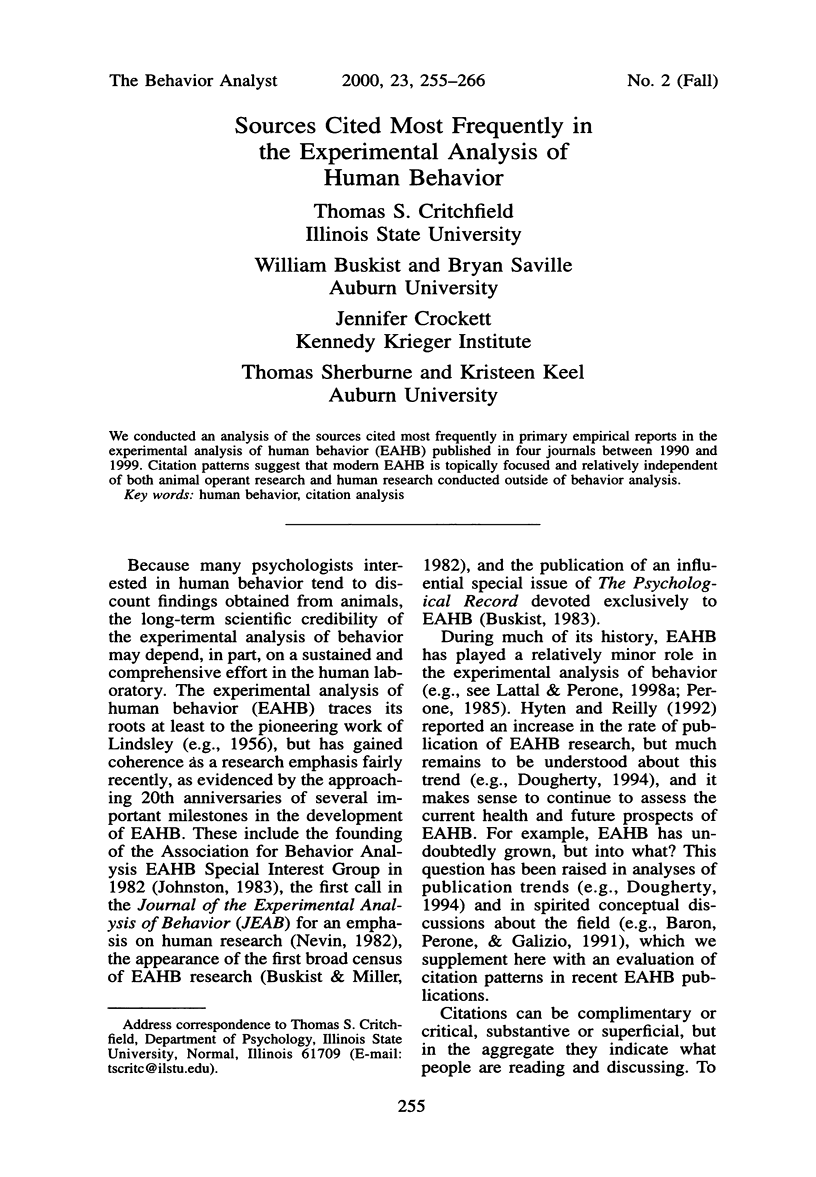
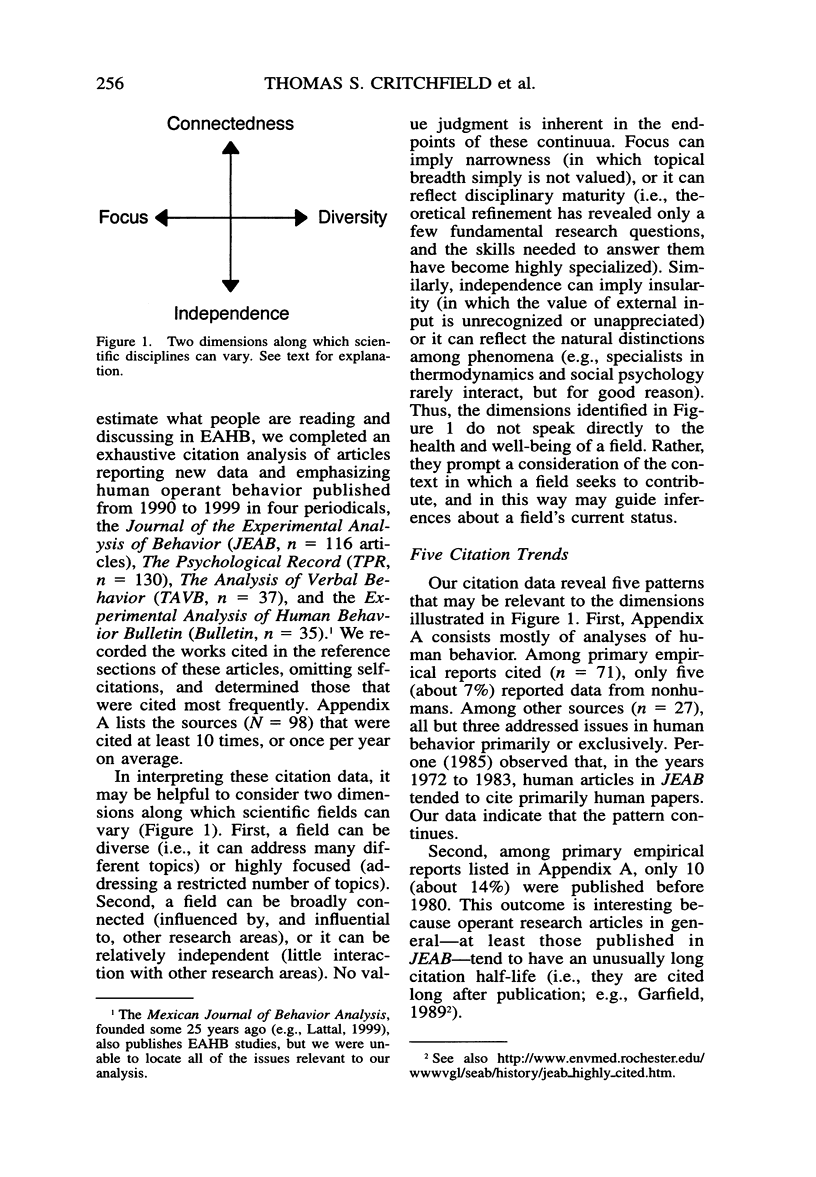
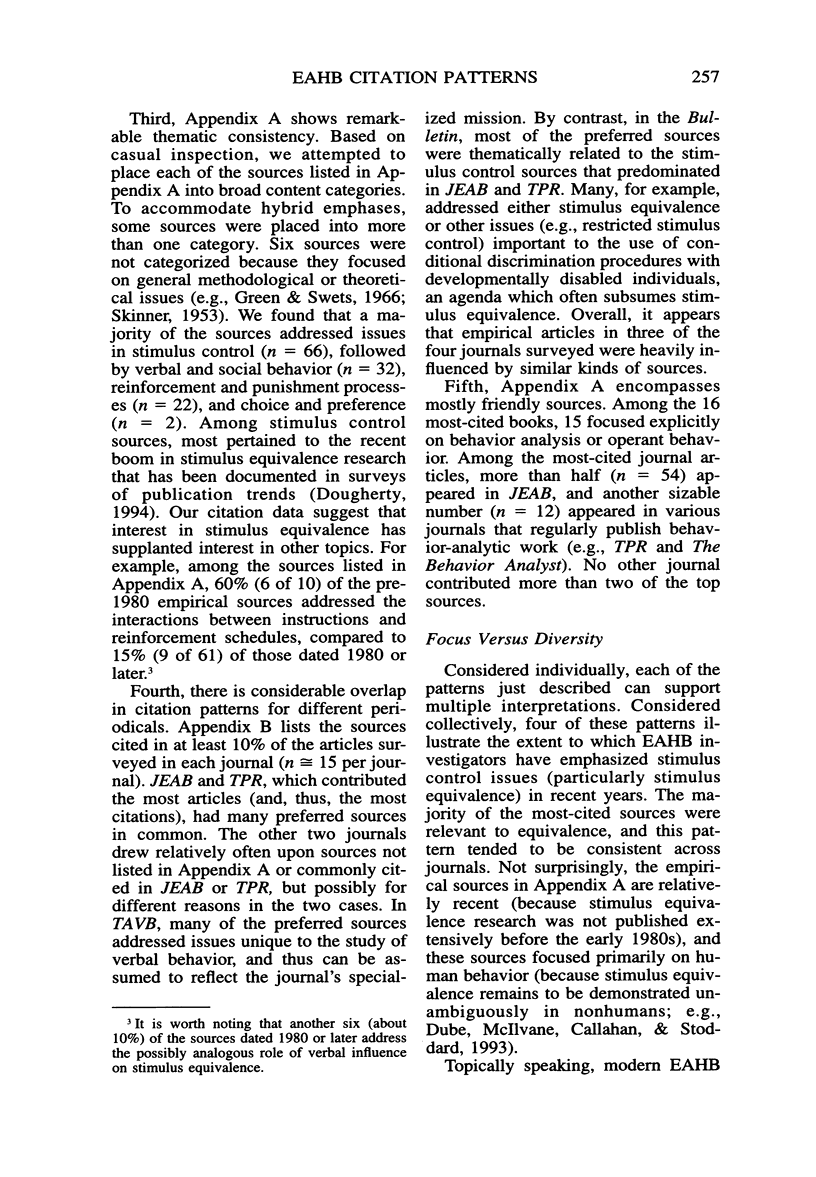
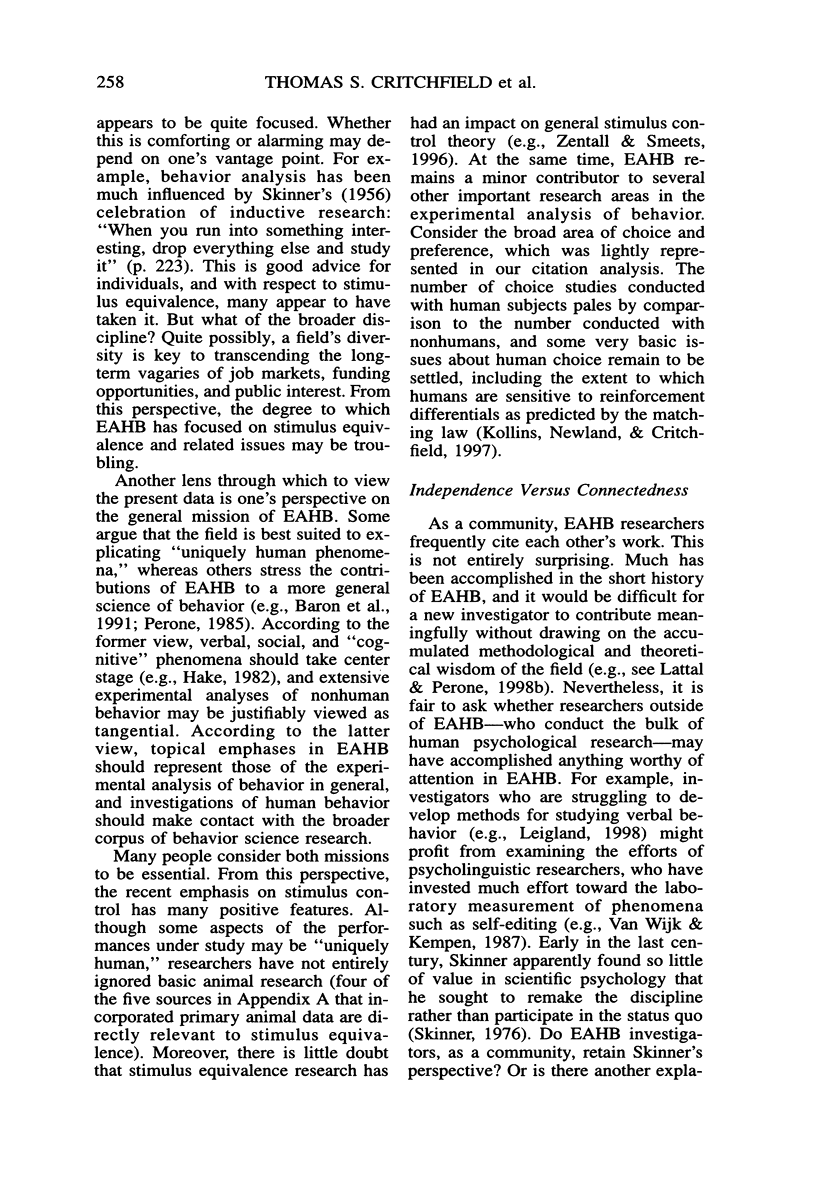
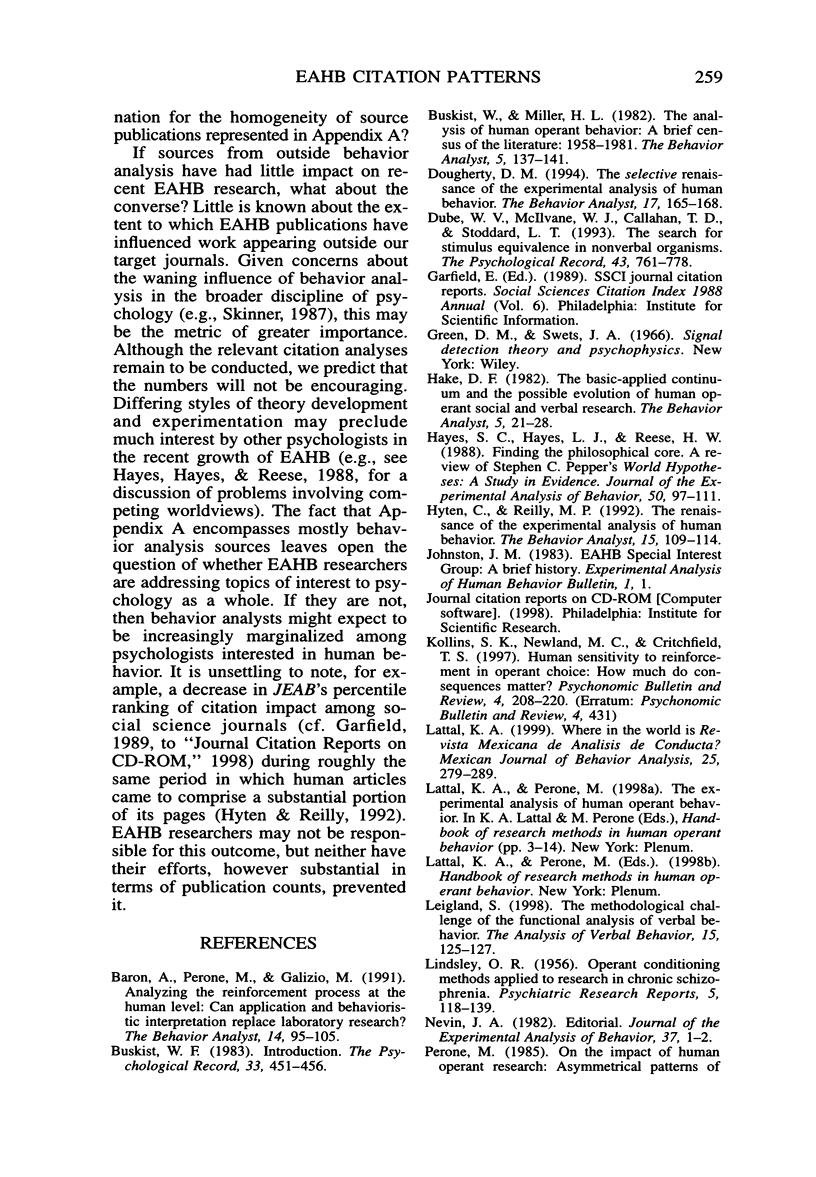
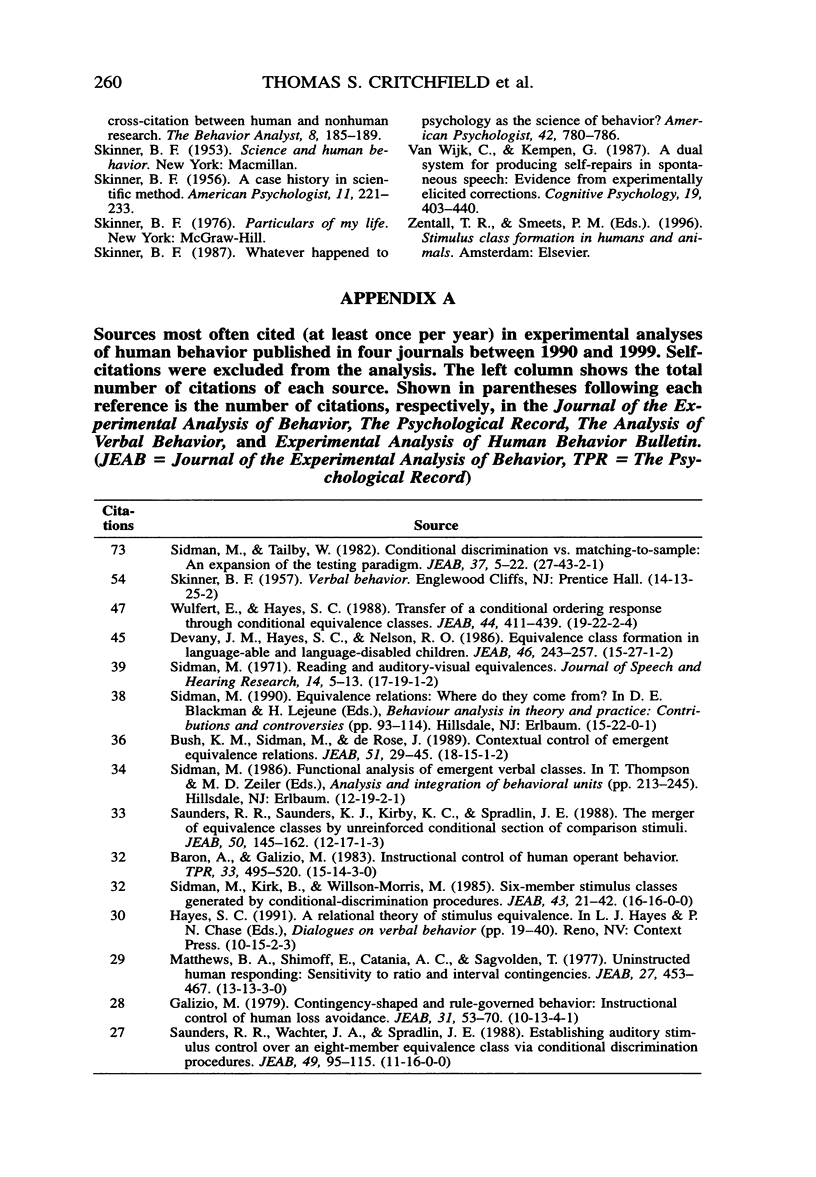
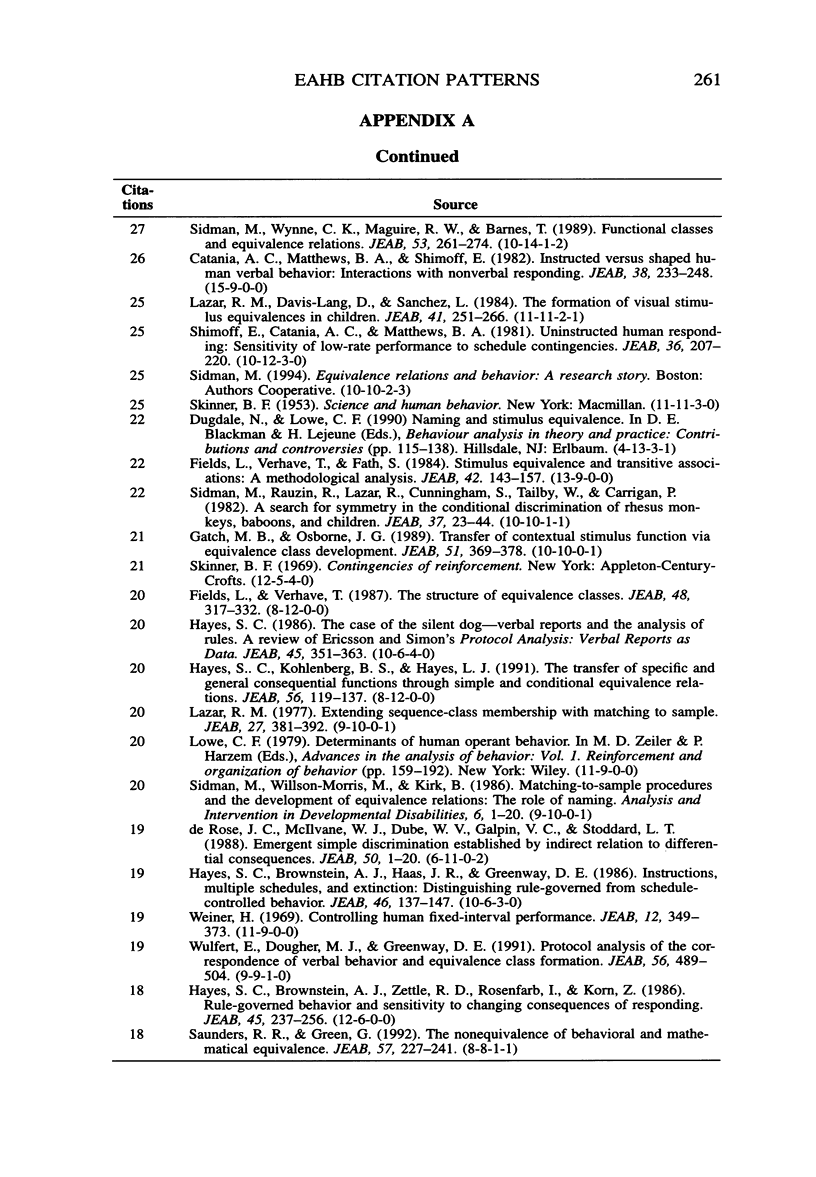
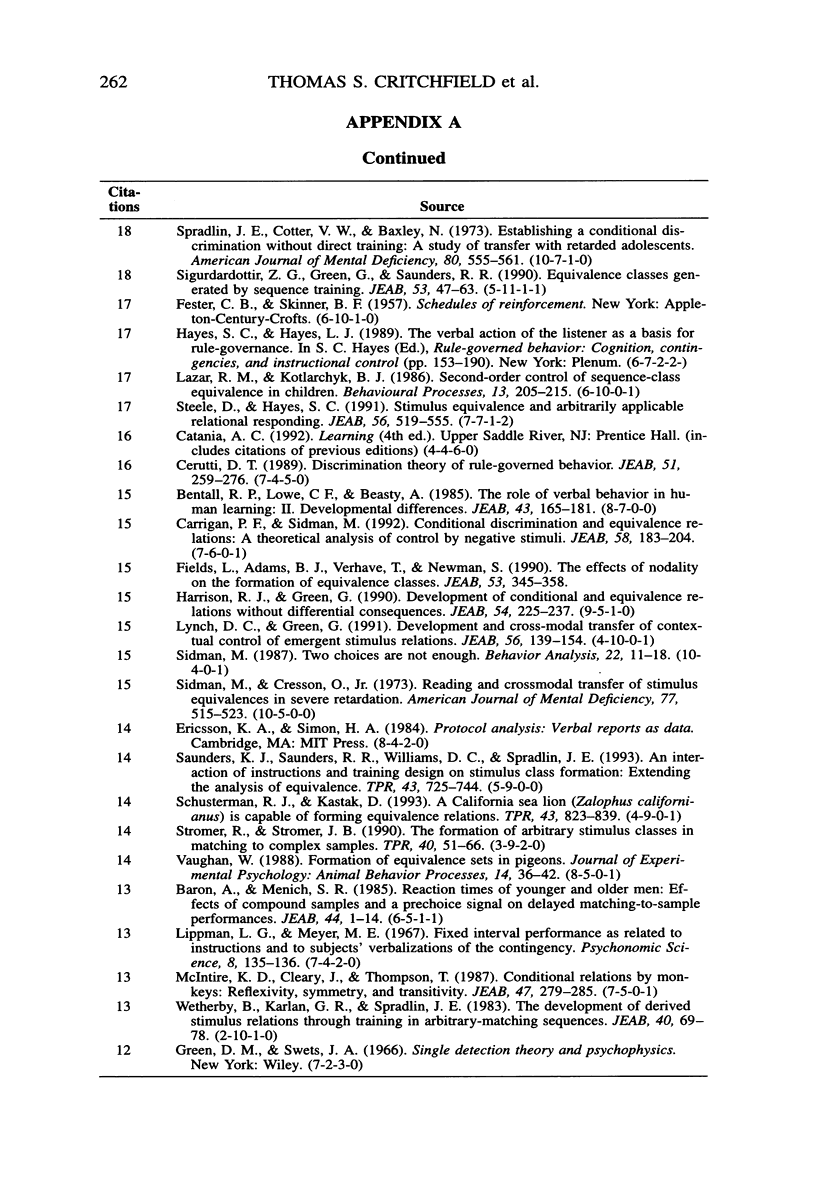
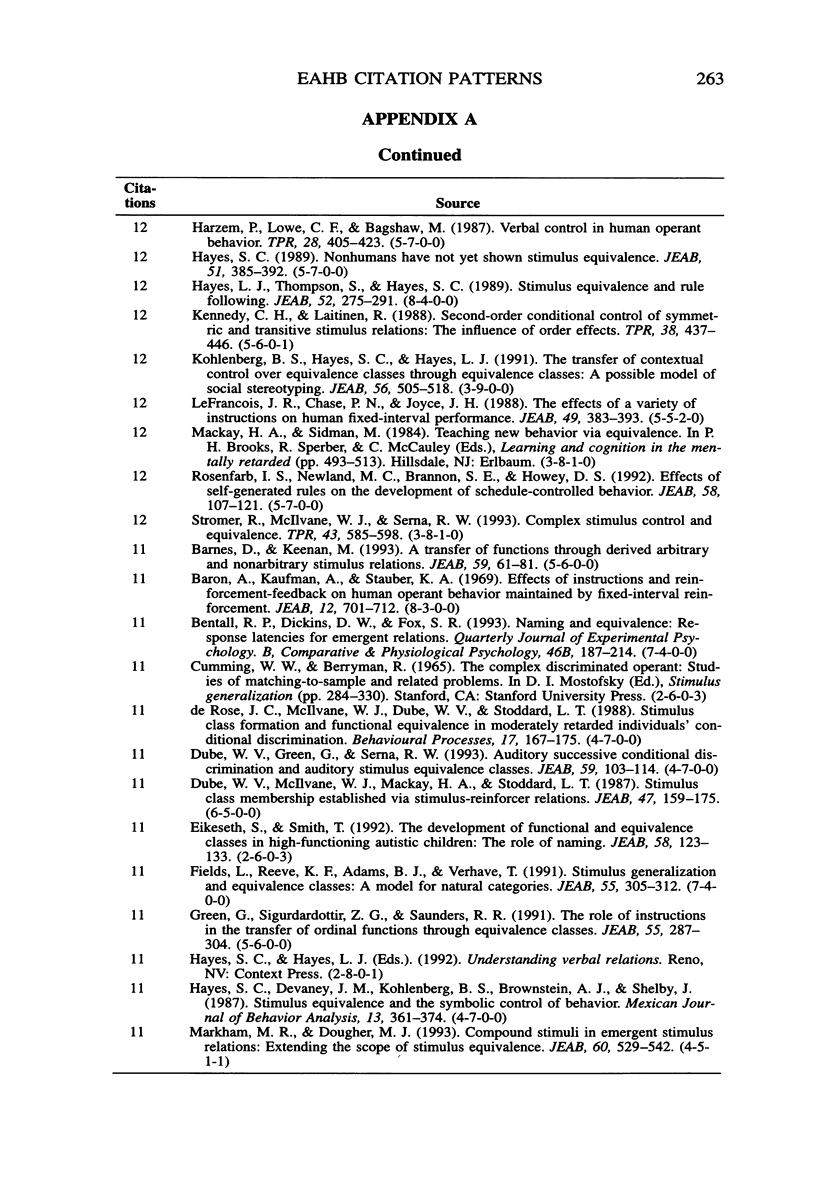
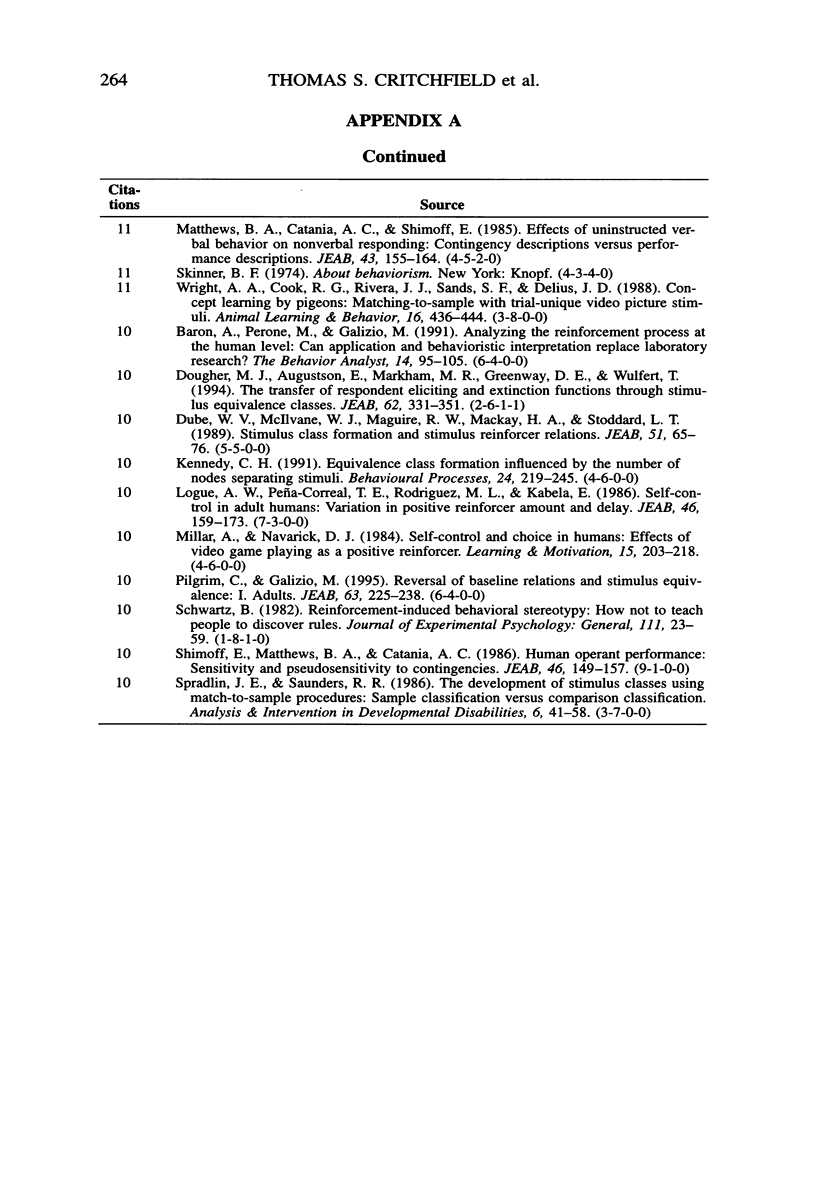
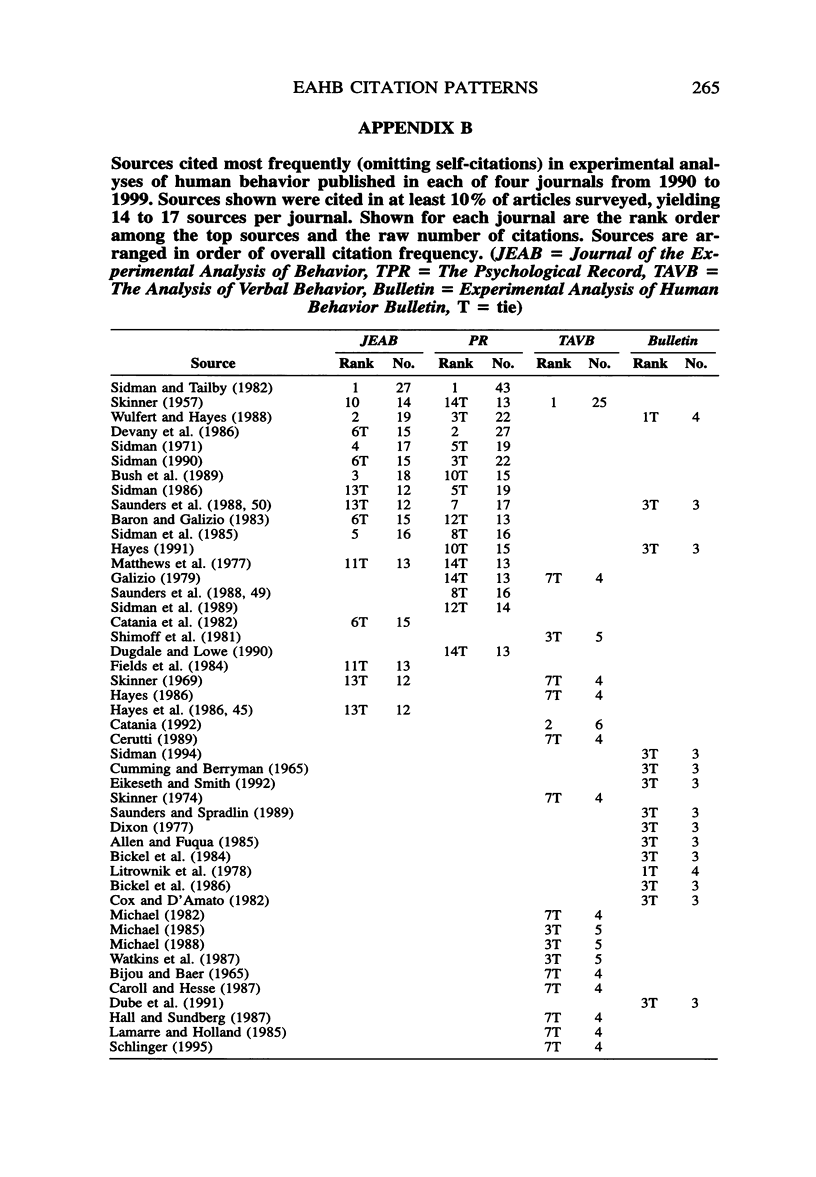
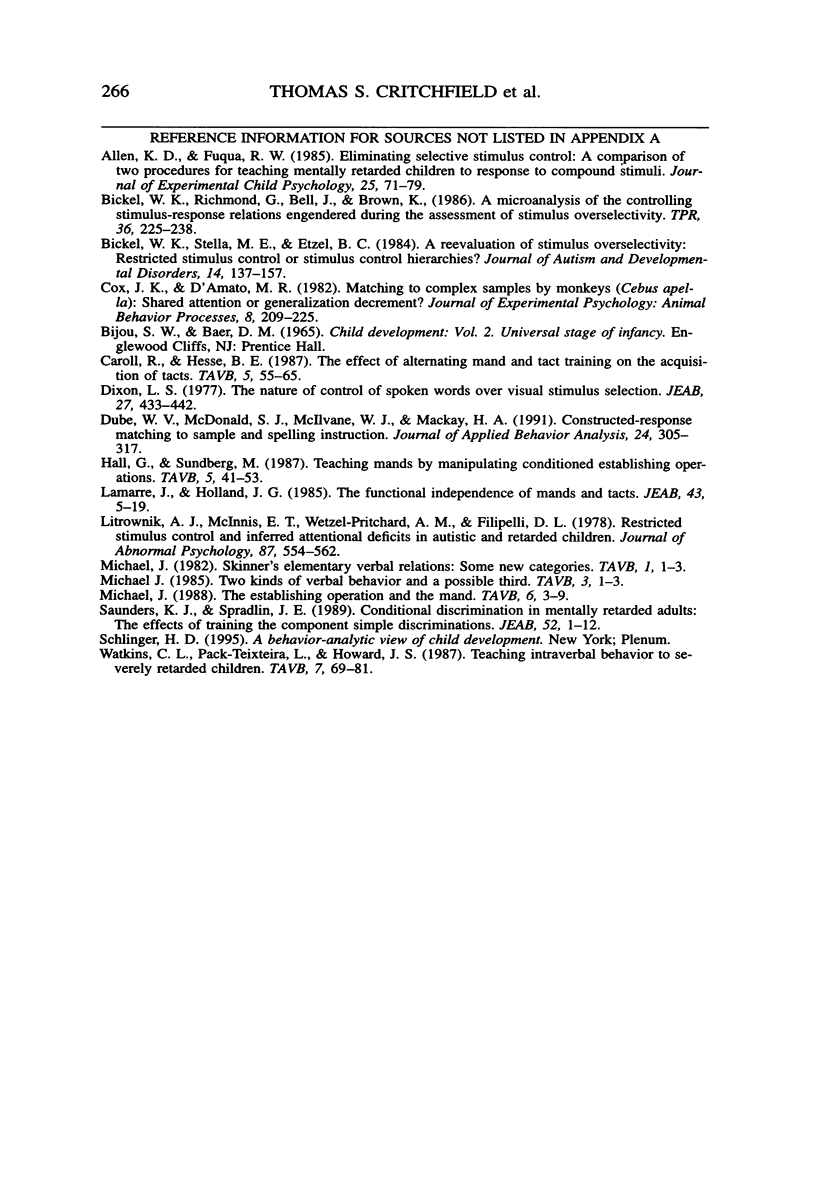
Selected References
These references are in PubMed. This may not be the complete list of references from this article.
- Allen K. D., Fuqua R. W. Eliminating selective stimulus control: a comparison of two procedures for teaching mentally retarded children to respond to compound stimuli. J Exp Child Psychol. 1985 Feb;39(1):55–71. doi: 10.1016/0022-0965(85)90029-3. [DOI] [PubMed] [Google Scholar]
- Barnes D., Keenan M. A transfer of functions through derived arbitrary and nonarbitrary stimulus relations. J Exp Anal Behav. 1993 Jan;59(1):61–81. doi: 10.1901/jeab.1993.59-61. [DOI] [PMC free article] [PubMed] [Google Scholar]
- Barnes D., Roche B. Mechanistic ontology and contextualistic epistemology: A contradiction within behavior analysis. Behav Anal. 1994 Spring;17(1):165–168. doi: 10.1007/BF03392662. [DOI] [PMC free article] [PubMed] [Google Scholar]
- Baron A., Kaufman A., Stauber K. A. Effects of instructions and reinforcement-feedback on human operant behavior maintained by fixed-interval reinforcement. J Exp Anal Behav. 1969 Sep;12(5):701–712. doi: 10.1901/jeab.1969.12-701. [DOI] [PMC free article] [PubMed] [Google Scholar]
- Baron A., Menich S. R. Reaction times of younger and older men: effects of compound samples and a prechoice signal on delayed matching-to-sample performances. J Exp Anal Behav. 1985 Jul;44(1):1–14. doi: 10.1901/jeab.1985.44-1. [DOI] [PMC free article] [PubMed] [Google Scholar]
- Baron A., Perone M., Galizio M. Analyzing the reinforcement process at the human level: can application and behavioristic interpretation replace laboratory research? Behav Anal. 1991 Fall;14(2):95–105. doi: 10.1007/BF03392557. [DOI] [PMC free article] [PubMed] [Google Scholar]
- Baron A., Perone M., Galizio M. Analyzing the reinforcement process at the human level: can application and behavioristic interpretation replace laboratory research? Behav Anal. 1991 Fall;14(2):95–105. doi: 10.1007/BF03392557. [DOI] [PMC free article] [PubMed] [Google Scholar]
- Bentall R. P., Lowe C. F., Beasty A. The role of verbal behavior in human learning: II. Developmental differences. J Exp Anal Behav. 1985 Mar;43(2):165–181. doi: 10.1901/jeab.1985.43-165. [DOI] [PMC free article] [PubMed] [Google Scholar]
- Bickel W. K., Stella M. E., Etzel B. C. A reevaluation of stimulus overselectivity: restricted stimulus control or stimulus control hierarchies. J Autism Dev Disord. 1984 Jun;14(2):136–157. doi: 10.1007/BF02409657. [DOI] [PubMed] [Google Scholar]
- Bush K. M., Sidman M., de Rose T. Contextual control of emergent equivalence relations. J Exp Anal Behav. 1989 Jan;51(1):29–45. doi: 10.1901/jeab.1989.51-29. [DOI] [PMC free article] [PubMed] [Google Scholar]
- Buskist W. F., Miller H. L., Jr The analysis of human operant behavior: A brief census of the literature: 1958-1981. Behav Anal. 1982 Fall;5(2):137–141. doi: 10.1007/BF03392382. [DOI] [PMC free article] [PubMed] [Google Scholar]
- Carrigan P. F., Sidman M. Conditional discrimination and equivalence relations: A theoretical analysis of control by negative stimuli. J Exp Anal Behav. 1992 Jul;58(1):183–204. doi: 10.1901/jeab.1992.58-183. [DOI] [PMC free article] [PubMed] [Google Scholar]
- Catania A. C., Matthews B. A., Shimoff E. Instructed versus shaped human verbal behavior: Interactions with nonverbal responding. J Exp Anal Behav. 1982 Nov;38(3):233–248. doi: 10.1901/jeab.1982.38-233. [DOI] [PMC free article] [PubMed] [Google Scholar]
- Cerutti D. T. Discrimination theory of rule-governed behavior. J Exp Anal Behav. 1989 Mar;51(2):259–276. doi: 10.1901/jeab.1989.51-259. [DOI] [PMC free article] [PubMed] [Google Scholar]
- Devany J. M., Hayes S. C., Nelson R. O. Equivalence class formation in language-able and language-disabled children. J Exp Anal Behav. 1986 Nov;46(3):243–257. doi: 10.1901/jeab.1986.46-243. [DOI] [PMC free article] [PubMed] [Google Scholar]
- Dixon L. S. The nature of control by spoken words over visual stimulus selection. J Exp Anal Behav. 1977 May;27(3):433–442. doi: 10.1901/jeab.1977.27-433. [DOI] [PMC free article] [PubMed] [Google Scholar]
- Dougher M. J., Augustson E., Markham M. R., Greenway D. E., Wulfert E. The transfer of respondent eliciting and extinction functions through stimulus equivalence classes. J Exp Anal Behav. 1994 Nov;62(3):331–351. doi: 10.1901/jeab.1994.62-331. [DOI] [PMC free article] [PubMed] [Google Scholar]
- Dube W. V., Green G., Serna R. W. Auditory successive conditional discrimination and auditory stimulus equivalence classes. J Exp Anal Behav. 1993 Jan;59(1):103–114. doi: 10.1901/jeab.1993.59-103. [DOI] [PMC free article] [PubMed] [Google Scholar]
- Dube W. V., McDonald S. J., McIlvane W. J., Mackay H. A. Constructed-response matching to sample and spelling instruction. J Appl Behav Anal. 1991 Summer;24(2):305–317. doi: 10.1901/jaba.1991.24-305. [DOI] [PMC free article] [PubMed] [Google Scholar]
- Dube W. V., McIlvane W. J., Mackay H. A., Stoddard L. T. Stimulus class membership established via stimulus-reinforcer relations. J Exp Anal Behav. 1987 Mar;47(2):159–175. doi: 10.1901/jeab.1987.47-159. [DOI] [PMC free article] [PubMed] [Google Scholar]
- Dube W. V., McIlvane W. J., Maguire R. W., Mackay H. A., Stoddard L. T. Stimulus class formation and stimulus-reinforcer relations. J Exp Anal Behav. 1989 Jan;51(1):65–76. doi: 10.1901/jeab.1989.51-65. [DOI] [PMC free article] [PubMed] [Google Scholar]
- Eikeseth S., Smith T. The development of functional and equivalence classes in high-functioning autistic children: the role of naming. J Exp Anal Behav. 1992 Jul;58(1):123–133. doi: 10.1901/jeab.1992.58-123. [DOI] [PMC free article] [PubMed] [Google Scholar]
- Fields L., Adams B. J., Verhave T., Newman S. The effects of nodality on the formation of equivalence classes. J Exp Anal Behav. 1990 May;53(3):345–358. doi: 10.1901/jeab.1990.53-345. [DOI] [PMC free article] [PubMed] [Google Scholar]
- Fields L., Reeve K. F., Adams B. J., Verhave T. Stimulus generalization and equivalence classes: a model for natural categories. J Exp Anal Behav. 1991 May;55(3):305–312. doi: 10.1901/jeab.1991.55-305. [DOI] [PMC free article] [PubMed] [Google Scholar]
- Fields L., Verhave T., Fath S. Stimulus equivalence and transitive associations: A methodological analysis. J Exp Anal Behav. 1984 Jul;42(1):143–157. doi: 10.1901/jeab.1984.42-143. [DOI] [PMC free article] [PubMed] [Google Scholar]
- Fields L., Verhave T. The structure of equivalence classes. J Exp Anal Behav. 1987 Sep;48(2):317–332. doi: 10.1901/jeab.1987.48-317. [DOI] [PMC free article] [PubMed] [Google Scholar]
- Galizio M. Contingency-shaped and rule-governed behavior: instructional control of human loss avoidance. J Exp Anal Behav. 1979 Jan;31(1):53–70. doi: 10.1901/jeab.1979.31-53. [DOI] [PMC free article] [PubMed] [Google Scholar]
- Gatch M. B., Osborne J. G. Transfer of contextual stimulus function via equivalence class development. J Exp Anal Behav. 1989 May;51(3):369–378. doi: 10.1901/jeab.1989.51-369. [DOI] [PMC free article] [PubMed] [Google Scholar]
- Green G., Sigurdardottir Z. G., Saunders R. R. The role of instructions in the transfer of ordinal functions through equivalence classes. J Exp Anal Behav. 1991 May;55(3):287–304. doi: 10.1901/jeab.1991.55-287. [DOI] [PMC free article] [PubMed] [Google Scholar]
- Hake D. F. The basic-applied continuum and the possible evolution of human operant social and verbal research. Behav Anal. 1982 Spring;5(1):21–28. doi: 10.1007/BF03393137. [DOI] [PMC free article] [PubMed] [Google Scholar]
- Harrison R. J., Green G. Development of conditional and equivalence relations without differential consequences. J Exp Anal Behav. 1990 Nov;54(3):225–237. doi: 10.1901/jeab.1990.54-225. [DOI] [PMC free article] [PubMed] [Google Scholar]
- Hayes L. J., Thompson S., Hayes S. C. Stimulus equivalence and rule following. J Exp Anal Behav. 1989 Nov;52(3):275–291. doi: 10.1901/jeab.1989.52-275. [DOI] [PMC free article] [PubMed] [Google Scholar]
- Hayes S. C., Brownstein A. J., Haas J. R., Greenway D. E. Instructions, multiple schedules, and extinction: Distinguishing rule-governed from schedule-controlled behavior. J Exp Anal Behav. 1986 Sep;46(2):137–147. doi: 10.1901/jeab.1986.46-137. [DOI] [PMC free article] [PubMed] [Google Scholar]
- Hayes S. C., Brownstein A. J., Zettle R. D., Rosenfarb I., Korn Z. Rule-governed behavior and sensitivity to changing consequences of responding. J Exp Anal Behav. 1986 May;45(3):237–256. doi: 10.1901/jeab.1986.45-237. [DOI] [PMC free article] [PubMed] [Google Scholar]
- Hayes S. C., Hayes L. J., Reese H. W. Finding the philosophical core: A review of Stephen C. Pepper's World Hypotheses: A Study in Evidence. J Exp Anal Behav. 1988 Jul;50(1):97–111. doi: 10.1901/jeab.1988.50-97. [DOI] [PMC free article] [PubMed] [Google Scholar]
- Hayes S. C., Kohlenberg B. S., Hayes L. J. The transfer of specific and general consequential functions through simple and conditional equivalence relations. J Exp Anal Behav. 1991 Jul;56(1):119–137. doi: 10.1901/jeab.1991.56-119. [DOI] [PMC free article] [PubMed] [Google Scholar]
- Hayes S. C. Nonhumans have not yet shown stimulus equivalence. J Exp Anal Behav. 1989 May;51(3):385–392. doi: 10.1901/jeab.1989.51-385. [DOI] [PMC free article] [PubMed] [Google Scholar]
- Hyten C., Reilly M. P. The renaissance of the experimental analysis of human behavior. Behav Anal. 1992 Fall;15(2):109–114. doi: 10.1007/BF03392593. [DOI] [PMC free article] [PubMed] [Google Scholar]
- Kohlenberg B. S., Hayes S. C., Hayes L. J. The transfer of contextual control over equivalence classes through equivalence classes: a possible model of social stereotyping. J Exp Anal Behav. 1991 Nov;56(3):505–518. doi: 10.1901/jeab.1991.56-505. [DOI] [PMC free article] [PubMed] [Google Scholar]
- LINDSLEY O. R. Operant conditioning methods applied to research in chronic schizophrenia. Psychiatr Res Rep Am Psychiatr Assoc. 1956 Jun;5:118-39; discussion, 140-53. [PubMed] [Google Scholar]
- Lamarre J., Holland J. G. The functional independence of mands and tacts. J Exp Anal Behav. 1985 Jan;43(1):5–19. doi: 10.1901/jeab.1985.43-5. [DOI] [PMC free article] [PubMed] [Google Scholar]
- Lazar R. M., Davis-Lang D., Sanchez L. The formation of visual stimulus equivalences in children. J Exp Anal Behav. 1984 May;41(3):251–266. doi: 10.1901/jeab.1984.41-251. [DOI] [PMC free article] [PubMed] [Google Scholar]
- Lazar R. Extending sequence-class membership with matching to sample. J Exp Anal Behav. 1977 Mar;27(2):381–392. doi: 10.1901/jeab.1977.27-381. [DOI] [PMC free article] [PubMed] [Google Scholar]
- Lefrancois J. R., Chase P. N., Joyce J. H. The effects of a variety of instructions on human fixed-interval performance. J Exp Anal Behav. 1988 May;49(3):383–393. doi: 10.1901/jeab.1988.49-383. [DOI] [PMC free article] [PubMed] [Google Scholar]
- Litrownik A. J., McInnis E. T., Wetzel-Pritchard A. M., Filipelli D. L. Restricted stimulus control and inferred attentional deficits in autistic and retarded children. J Abnorm Psychol. 1978 Oct;87(5):554–562. [PubMed] [Google Scholar]
- Logue A. W., Peña-Correal T. E., Rodriguez M. L., Kabela E. Self-control in adult humans: variation in positive reinforcer amount and delay. J Exp Anal Behav. 1986 Sep;46(2):159–173. doi: 10.1901/jeab.1986.46-159. [DOI] [PMC free article] [PubMed] [Google Scholar]
- Lynch D. C., Green G. Development and crossmodal transfer of contextual control of emergent stimulus relations. J Exp Anal Behav. 1991 Jul;56(1):139–154. doi: 10.1901/jeab.1991.56-139. [DOI] [PMC free article] [PubMed] [Google Scholar]
- Markham M. R., Dougher M. J. Compound stimuli in emergent stimulus relations: Extending the scope of stimulus equivalence. J Exp Anal Behav. 1993 Nov;60(3):529–542. doi: 10.1901/jeab.1993.60-529. [DOI] [PMC free article] [PubMed] [Google Scholar]
- Matthews B. A., Catania A. C., Shimoff E. Effects of uninstructed verbal behavior on nonverbal responding: Contingency descriptions versus performance descriptions. J Exp Anal Behav. 1985 Mar;43(2):155–164. doi: 10.1901/jeab.1985.43-155. [DOI] [PMC free article] [PubMed] [Google Scholar]
- Matthews B. A., Shimoff E., Catania A. C., Sagvolden T. Uninstructed human responding: sensitivity to ratio and interval contingencies. J Exp Anal Behav. 1977 May;27(3):453–467. doi: 10.1901/jeab.1977.27-453. [DOI] [PMC free article] [PubMed] [Google Scholar]
- McIntire K. D., Cleary J., Thompson T. Conditional relations by monkeys: Reflexivity, symmetry, and transitivity. J Exp Anal Behav. 1987 May;47(3):279–285. doi: 10.1901/jeab.1987.47-279. [DOI] [PMC free article] [PubMed] [Google Scholar]
- Nevin J. A. Editorial. J Exp Anal Behav. 1982 Jan;37(1):1–2. doi: 10.1901/jeab.1982.37-1. [DOI] [PMC free article] [PubMed] [Google Scholar]
- doi: 10.1901/jeab.1986.45-351. [DOI] [PMC free article] [Google Scholar]
- Perone M. On the impact of human operant research: Asymmetrical patterns of cross-citation between human and nonhuman research. Behav Anal. 1985 Fall;8(2):185–189. doi: 10.1007/BF03393150. [DOI] [PMC free article] [PubMed] [Google Scholar]
- Pilgrim C., Galizio M. Reversal of baseline relations and stimulus equivalence: I. Adults. J Exp Anal Behav. 1995 May;63(3):225–238. doi: 10.1901/jeab.1995.63-225. [DOI] [PMC free article] [PubMed] [Google Scholar]
- Rosenfarb I. S., Newland M. C., Brannon S. E., Howey D. S. Effects of self-generated rules on the development of schedule-controlled behavior. J Exp Anal Behav. 1992 Jul;58(1):107–121. doi: 10.1901/jeab.1992.58-107. [DOI] [PMC free article] [PubMed] [Google Scholar]
- Saunders K. J., Spradlin J. E. Conditional discrimination in mentally retarded adults: the effect of training the component simple discriminations. J Exp Anal Behav. 1989 Jul;52(1):1–12. doi: 10.1901/jeab.1989.52-1. [DOI] [PMC free article] [PubMed] [Google Scholar]
- Saunders R. R., Green G. The nonequivalence of behavioral and mathematical equivalence. J Exp Anal Behav. 1992 Mar;57(2):227–241. doi: 10.1901/jeab.1992.57-227. [DOI] [PMC free article] [PubMed] [Google Scholar]
- Saunders R. R., Saunders K. J., Kirby K. C., Spradlin J. E. The merger and development of equivalence classes by unreinforced conditional selection of comparison stimuli. J Exp Anal Behav. 1988 Sep;50(2):145–162. doi: 10.1901/jeab.1988.50-145. [DOI] [PMC free article] [PubMed] [Google Scholar]
- Saunders R. R., Wachter J., Spradlin J. E. Establishing auditory stimulus control over an eight-member equivalence class via conditional discrimination procedures. J Exp Anal Behav. 1988 Jan;49(1):95–115. doi: 10.1901/jeab.1988.49-95. [DOI] [PMC free article] [PubMed] [Google Scholar]
- Shimoff E., Catania A. C., Matthews B. A. Uninstructed human responding: Sensitivity of low-rate performance to schedule contingencies. J Exp Anal Behav. 1981 Sep;36(2):207–220. doi: 10.1901/jeab.1981.36-207. [DOI] [PMC free article] [PubMed] [Google Scholar]
- Shimoff E., Matthews B. A., Catania A. C. Human operant performance: Sensitivity and pseudosensitivity to contingencies. J Exp Anal Behav. 1986 Sep;46(2):149–157. doi: 10.1901/jeab.1986.46-149. [DOI] [PMC free article] [PubMed] [Google Scholar]
- Sidman M., Cresson O., Jr Reading and crossmodal transfer of stimulus equivalences in severe retardation. Am J Ment Defic. 1973 Mar;77(5):515–523. [PubMed] [Google Scholar]
- Sidman M., Kirk B., Willson-Morris M. Six-member stimulus classes generated by conditional-discrimination procedures. J Exp Anal Behav. 1985 Jan;43(1):21–42. doi: 10.1901/jeab.1985.43-21. [DOI] [PMC free article] [PubMed] [Google Scholar]
- Sidman M., Rauzin R., Lazar R., Cunningham S., Tailby W., Carrigan P. A search for symmetry in the conditional discriminations of rhesus monkeys, baboons, and children. J Exp Anal Behav. 1982 Jan;37(1):23–44. doi: 10.1901/jeab.1982.37-23. [DOI] [PMC free article] [PubMed] [Google Scholar]
- Sidman M. Reading and auditory-visual equivalences. J Speech Hear Res. 1971 Mar;14(1):5–13. doi: 10.1044/jshr.1401.05. [DOI] [PubMed] [Google Scholar]
- Sidman M., Tailby W. Conditional discrimination vs. matching to sample: an expansion of the testing paradigm. J Exp Anal Behav. 1982 Jan;37(1):5–22. doi: 10.1901/jeab.1982.37-5. [DOI] [PMC free article] [PubMed] [Google Scholar]
- Sidman M., Wynne C. K., Maguire R. W., Barnes T. Functional classes and equivalence relations. J Exp Anal Behav. 1989 Nov;52(3):261–274. doi: 10.1901/jeab.1989.52-261. [DOI] [PMC free article] [PubMed] [Google Scholar]
- Sigurdardottir Z. G., Green G., Saunders R. R. Equivalence classes generated by sequence training. J Exp Anal Behav. 1990 Jan;53(1):47–63. doi: 10.1901/jeab.1990.53-47. [DOI] [PMC free article] [PubMed] [Google Scholar]
- Steele D., Hayes S. C. Stimulus equivalence and arbitrarily applicable relational responding. J Exp Anal Behav. 1991 Nov;56(3):519–555. doi: 10.1901/jeab.1991.56-519. [DOI] [PMC free article] [PubMed] [Google Scholar]
- Weiner H. Controlling human fixed-interval performance. J Exp Anal Behav. 1969 May;12(3):349–373. doi: 10.1901/jeab.1969.12-349. [DOI] [PMC free article] [PubMed] [Google Scholar]
- Wetherby B., Karlan G. R., Spradlin J. E. The development of derived stimulus relations through training in arbitrary-matching sequences. J Exp Anal Behav. 1983 Jul;40(1):69–78. doi: 10.1901/jeab.1983.40-69. [DOI] [PMC free article] [PubMed] [Google Scholar]
- Wulfert E., Dougher M. J., Greenway D. E. Protocol analysis of the correspondence of verbal behavior and equivalence class formation. J Exp Anal Behav. 1991 Nov;56(3):489–504. doi: 10.1901/jeab.1991.56-489. [DOI] [PMC free article] [PubMed] [Google Scholar]
- de Rose J. C., McIlvane W. J., Dube W. V., Galpin V. C., Stoddard L. T. Emergent simple discrimination established by indirect relation to differential consequences. J Exp Anal Behav. 1988 Jul;50(1):1–20. doi: 10.1901/jeab.1988.50-1. [DOI] [PMC free article] [PubMed] [Google Scholar]


